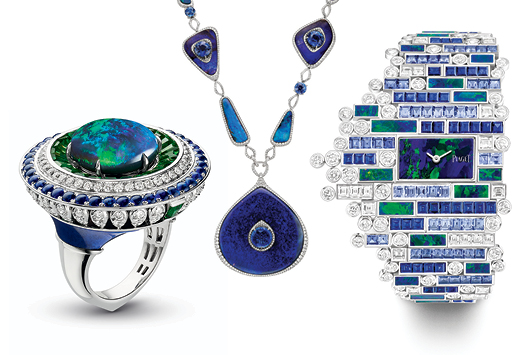
If there is one gem that brings out the colorist in a jeweler, it’s the opal. Each individual stone fires off a different pattern of rainbow-hued optical illusions that have designers enraptured.
Color-obsessed Victoire de Castellane, creative director of Christian Dior’s jewelry division, selected a variety of vivid gemstones to highlight the hues flashing in the opals of her Dior et Toi collection. Opal, to her, is a poetic stone — “an invitation to enter a fairytale,” she says, naming black opals as her favorite for their “vibrant play of colors.”
High jeweler Albert Boghossian is similarly rhapsodic. “It is like looking at a canvas of colorful brushstrokes,” he muses. And to Australia-based designer Margot McKinney, they “look like they have been plucked out of the sea or from an exotic reef, with their enigmatic play of blue [and] green to orange and pink.”
Valuable history
The first to mention opal was Pliny the Elder in the first century, and the earliest confirmed find was in what is now Slovakia. However, it was an 1849 discovery in Australia that triggered the opal boom in the jewelry trade. The first Queensland opals arrived in London’s Hatton Garden jewelry district in the 1880s, and the gemstone found its way into the Arts & Crafts movement.
Britain’s Queen Victoria was an early opal fan, influencing tastes around the empire. In the US, Louis Comfort Tiffany used opal with enamel, garnet and tourmalines in signature motifs like dragonflies. Light opal’s milky iridescence famously inspired the naturalistic Art Nouveau designs of René Lalique and Georges Fouquet, and later appeared in the works of designer Sybil Dunlop in the 1920s and ’30s.
Today, these stones are back on trend — especially the black, boulder and Ethiopian varieties — thanks to a big increase in millennial customers, according to online marketplace Opal Auctions. This has sparked a search for wholesale opals in the $1,000 to $3,000 price range.
Australian black opal from Lightning Ridge in New South Wales is the most revered variety, often priced by the piece rather than the carat, explains Stuart Robertson, research director at trade publication GemGuide. “I have seen pieces at the Tucson gem shows [in Arizona] with wholesale prices well above $15,000 per carat. Top black and semi-black material can see prices that exceed those of better grades of emerald and sapphire, especially when the latter are of the more commonly traded sizes of 1 to 5 carats.”
The most commonly seen sizes of fine-quality black opal — under 8 carats — range from just below $1,000 up to $7,000 per carat. “Prices get higher for larger sizes and exceptional pieces,” notes Robertson.
About the shape of it
Cabochons are the most desirable shape for most of the market, says Damien Cody of Australian supplier Cody Opals. “There is also strong demand for free-shape stones [among] the bespoke designer segment. Boulder opal, which is fashioned from the host rock and follows the natural contours of the opal vein, can provide a tactile and sculptural element for designers.”
Boghossian has capitalized on this natural shaping feature in his new high-jewelry collection, which includes a pair of heart-shaped diamonds — one white, one yellow — atop two heart-shaped opals.
“We love to set precious opals in earrings because each is distinctively individual, and this allows us to be more creative and give light to mismatched beauties,” he explains. “It is quite exciting to go beyond the realm of classical jewelry into more audacious territories.”
Cartier, which created a stunning matrix opal cuff last year, highlights the stone’s pebble-like irregular shapes in a necklace from its new Sur-Naturel line. The design “plays with round shapes as an evocation of a panther pattern illustrated by opals,” explains Pierre Rainero, Cartier’s head of heritage and style. “The daring composition of the necklace is a milestone in the evolution of Cartier design today.”
Dazzling by design
Beautiful black-opal specimens appear in high-jewelry collections from Chaumet, Tiffany & Co. and David Morris, and in many of Piaget’s hardstone dial watches.
California-based designer Irene Neuwirth uses Lightning Ridge, boulder, crystal and fire opals — another popular type — in her jewelry, while New York-based Deirdre Featherstone’s fascination with the gemstone has led her to use Koroit opal from Queensland (blackish with red flecks) as well as matrix, fire and black opal in her works. Temple St. Clair highlights Lightning Ridge and translucent water opal in her designs. Light opal from the Australian town of Coober Pedy sits alongside white clam pearls in Cartier’s high-jewelry repertoire, and New York-based brand Le Vian works with opals from the Yaweh mine in Ethiopia — where deposits were found in the 1990s — because of their high iridescence. McKinney, meanwhile, a winner of the International Opal Jewellery Design Award, has dedicated herself to finding the most interesting gems so she can emphasize their beauty.
“Living in Australia, I have incredible access to some of the finest opals in the world,” she says. “I am a fan of jewels the wearer has the chance to admire as well. This means cuffs and rings are favorites. [However,] a fabulous pair of boulder opal earrings can make such a statement.”
Images: Piaget; Chaumet; Boghossian
Article from the Rapaport Magazine - September 2020. To subscribe click here.